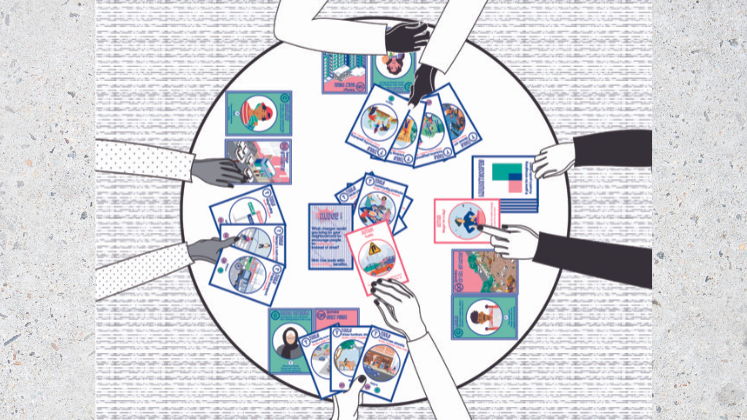Drawing on their work on a major international and interdisciplinary research project, Alla Konnikov, Irina Rets and Karen D Hughes provide four lessons for researchers undertaking similar projects to reflect on.
Interdisciplinarity is vital to addressing complex social challenges and promoting innovative research. This is particularly true when exploring emerging topics, such as the role of Artificial Intelligence (AI) in automated social systems and interactions. Yet, interdisciplinary collaboration poses conceptual and methodological challenges that require unique strategies and solutions. Reflecting on our work on the recent BIAS project, we traced some of the challenges we faced carrying out interdisciplinary research and the strategies we developed to mitigate them. You can read our findings in detail in our recent book chapter; here we want to summarise some of the key points.
The BIAS project is a bilateral (Canada – UK) interdisciplinary research initiative that seeks to understand the role of AI in shaping labour market inequalities. The project brings together scholars from diverse disciplines, such as mathematical & statistical sciences, computing & communications, sociology, and management. Working on such a complex project we decided to conduct our own internal research into the challenges and strategies in working across disciplines.
This research was undertaken in stages, as the project unfolded. We conducted interviews with the founding members of the project about the formation of the project team. Next, we administered a survey to the full team to gather information on effective interdisciplinary collaboration. The analysis of this data helped to reflect on our own collaborative experience and highlighted effective strategies such as flexibility, ‘interdisciplinary mindsets’, and unique communication styles. Next, we formulated our ‘lessons learned’ to be disseminated to anyone interested in interdisciplinary work.
1. How to establish an interdisciplinary research project?
‘The idea of the project came up in a coffee shop.’ Interdisciplinary project teams are more easily formed when there are pre-existing professional relationships developed through conferences, professional events, and working at the same institution. Some connections among the Co-investigators of the project went back many years (graduate school colleagues), while others were more recent (colleagues meeting at an event at their university designed to spur interdisciplinary research). This finding highlights the key role of the research institutions and funders in enhancing the capacity for interdisciplinary research through structural supports that connect researchers across different disciplines, faculties and across countries.
2. How to establish interdisciplinary communication?
Openness and flexibility: ‘We all had to carve out and include and exclude bits of our interests to make this collaboration work…’ As the objectives of the project could not be achieved by one discipline alone, the willingness to accommodate various intellectual interests and goals in the project was paired with a degree of compromise. Instead of striving for homogeneity and sameness, our strategy was to bridge the interdisciplinary differences and build on disciplinary strengths.
Developing common language: “We have different terminologies in different disciplines. But, we all tend to understand diagrams and graphs in the same way…” The employment of visual tools, such as pictures, graphs, and figures to summarise ideas and concepts was a key strategy used by the project team to facilitate interdisciplinary communication.
Interdisciplinary ‘translation’: ‘Sometimes the translator role in the project can be very important to facilitate intra-disciplinary dialogue.’ Some members of the team took on responsibility for bridging the communication gap between different disciplines. This finding underscores the importance of the intellectual and administrative coordination through a ‘super bridger’ – a role naturally taken by a few members of the team who ‘fell in between categories’ and had a solid understanding of the concepts and methods used in the different disciplines.
3. How to achieve interdisciplinary research goals?
Pairing methods from the different disciplines: Instead of ‘waiting for the next five-ten years to import methods from another discipline, within an interdisciplinary project we could do it at once.’ Interdisciplinary research can bolster professional development and innovation in unique ways. Collaboration between social and computer scientists resulted in a unique combination of methods that included a development of the novel word inventory (social sciences) for identifying a biased language that was then used for a large-scale computational analysis of the job postings (computer sciences).
4. How to achieve interdisciplinary outcomes and what implications does this have for academic careers?
‘It is important to recognise and make sure that the early career researchers are protected’ . Being part of an interdisciplinary project can be associated with both increased risks and opportunities for the early-career researchers, who are first expected to gain sufficient expertise in their own disciplines, including publications. However, interdisciplinarity teaches early-career researchers lessons of open-mindedness and that ‘big’ research problems cannot be solved within one discipline. In terms of disseminating our scholarly work, the team identified a few top-tier interdisciplinary journals that were not an obvious choice for some of the team members within their disciplines. The team accepted that targeting such journals would require prolonged investment, but could result in ‘higher return’ and a more significant intellectual contribution to interdisciplinarity.
Working in a large, international, interdisciplinary project has been different from much of our everyday academic work. Interdisciplinary work requires more investment in time, learning, coordination, and building effective communication. There are also compromises in terms of including and excluding personal research interests. That said, we also recognise that interdisciplinarity has pushed our work past the constraints of a single discipline. Though sparked by the nature of the grant, our project’s interdisciplinary design has enabled the study of a complex real-life problem – bias – and encouraged each of us to perceive our own disciplinary approaches and methods in a new light.
This post draws on Konnikov, A., Rets, I., Hughes, K. D., Al-Ani, J. A., Denier, N., Ding, L., Hu, S., Hu, Y., Jiang, B., Kong, L., Tarafdar, M., & Yu, D. (2022). Responsible AI for labour market equality (BIAS). In L. Hantrais (Ed.). How to Manage International Multidisciplinary Research Projects. Cheltenham: Edward Elgar Publishing.
The content generated on this blog is for information purposes only. This Article gives the views and opinions of the authors and does not reflect the views and opinions of the Impact of Social Science blog (the blog), nor of the London School of Economics and Political Science. Please review our comments policy if you have any concerns on posting a comment below.
Image Credit: Hannah Busing via Unsplash.







